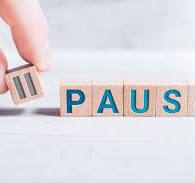
How Do You Pause? The Secret to Powerful, Clear, and HUMAN-Sounding Speech
Why Pausing Feels Hard
If you're not used to pausing, it's difficult. What do you do while you pause? It has to be more than just the absence of words, and you can't practice doing nothing.
So what do you do when you pause? You breathe. You inhale. Speech is powered by breath. Breath is the inspiration for speech. There has to be time for breath to enter your body.
That in-breath creates the pause naturally — and here's the thing: we hear a human behind a voice that breathes, and we want to hear ideas from humans, not robots. That subtle rhythm signals trust and presence to your listeners.

The Breath Pause: More Than Silence
Making an impact requires you to put something out there in the room. As a speaker, that "something" is primarily your voice — and your voice is powered by breath. A pause gives you the opportunity to gather that breath, and in doing so, to sound fully human: alive, present, and trustworthy.
Breathing in connects you to your inner experience, the impulse that moves you to speak in the first place. Think of it like this:
- The incoming breath reveals how you feel.
- The outgoing breath expresses how you feel.
That pause isn't dead air time. Compare it to holding your breath, freezing… When the pause is connected to your breath, it is alive with expectation and potential. It creates anticipation.
Pausing Sharpens Communication
Pausing to breathe in enhances the clarity of your message. Much of the actual process of communication takes place in the silence. It's in those spaces between phrases that your listeners absorb what you've said (and how you said it).
Without those pauses, your message becomes a blur of words. Nothing has an opportunity to penetrate and take root.
Staying in Command
One of the biggest benefits of the breath pause is that it keeps you in command of your performance. Many speakers unconsciously rush themselves. They start to feel like someone running down a steep hill. Before long, they're out of control. Then panic sets in.
Pausing frequently to breathe brings a deliberate, human rhythm to your speech. You have time to think, speak clearly, and connect with your listeners.

Exercises to Reinforce Breath
1. Poem or Rhyme Exercise
- Speak a line, then close your mouth. Wait for your body to fill with breath.
- Read the next line. Close your mouth again.
Tip: Imagine breathing in a lovely smell to stay relaxed.
(Credit: Caroline Goyder)
Example:
Mary had a little lamb //
Its fleece was white as snow //
And everywhere that Mary went //
Her sheep was sure to go. //
2. Open-Mouth Option
- Allow your lungs to fill at the end of a clause, without closing your mouth.
Speaking Exercise Example:
Everything I say is the result of thought //
Every thought I have needs a breath //
Breathing is also known as inspiration //
Therefore I inspire the thought with breath //
Which in turn becomes sound //
And with articulation becomes speech //
Then I can turn the speech into words //
In order to share with the audience my original thought. ///
(Adapted from Royal Academy of Dramatic Art, London)
Practice Tip: Start exaggeratedly slow, then ease back. Notice how breathing makes you feel grounded, in control, and fully human.
Marking for Pauses
- / short pause after a phrase or to emphasize a word
- // mid-length pause, breaks up sections or emphasizes a phrase
- /// long pause, generally between sentences
Example passage (workplace conversation)
Ms. Reynolds? // I hope I'm not disturbing you. /// May I have a moment? /// As you know, / I've been leading the marketing team for eight years now. /// I'm proud of the campaigns I've launched: // they consistently exceeded targets, / brought in new clients, / and strengthened our brand reputation. ///
However, / despite these results, // my responsibilities have increased dramatically, / and my compensation has remained the same. /// I truly enjoy working here, // but I'm struggling to keep up with the rising costs at home. /// I have a family to support, // and unless my salary reflects my contributions, // I may have to consider other options. ///
Bringing It Into Your Own Speaking
Take some text relevant to your work or interests, mark it for pauses, and speak aloud, carrying the same breath patterns.
Remember: humans trust humans. Your pauses, powered by breath, signal life, presence, and authority. You are in command of your performance.
Final thought: Pausing isn't just silence — it's the heartbeat of your speech. Let your breath guide your words, and watch your message resonate.
Start small by pausing intentionally in your next conversation, or take it further with a coaching session to explore your pauses in real time and receive personalized feedback.
